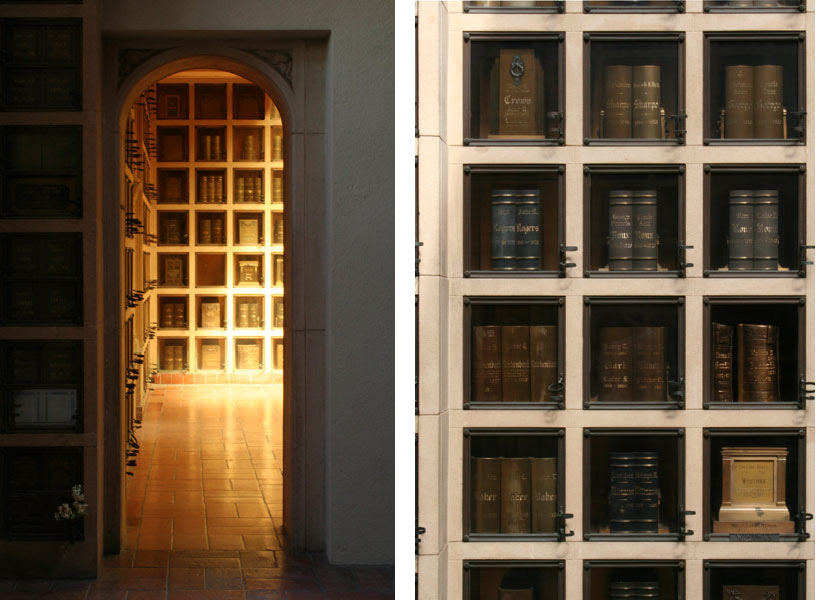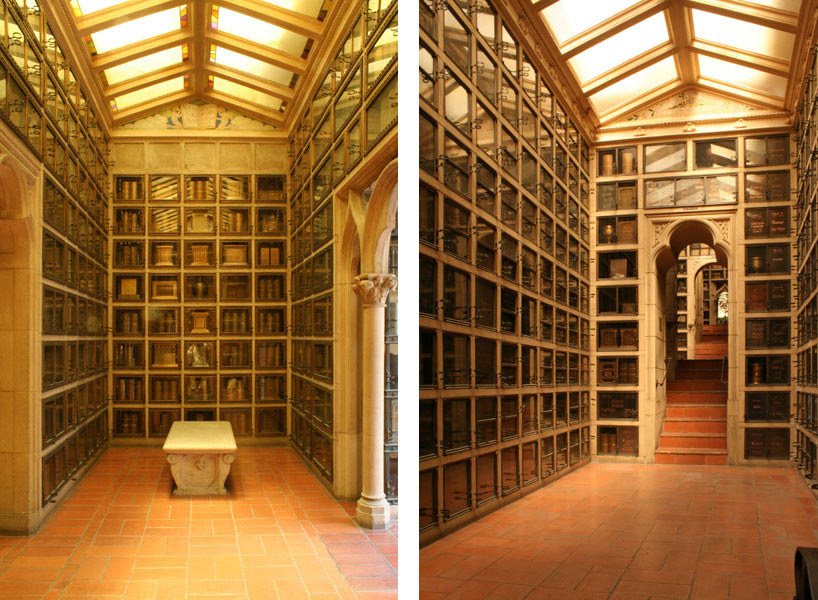Library of Souls
By Max Levy
Texas Architect Magazine
November 2015
Louis Kahn was late for his lecture. The U. C. Berkeley student center ballroom was packed with people eager to hear the great man that spring evening in 1968. But nearly an hour past his scheduled appearance…….still no Louis. Where was he? Speaking recently to my former Berkeley architecture professor, Richard Peters, now in his eighties, the reason for our wait became clear after all these years.
Professor Peters showed Kahn around before the lecture. On the assumption that the master had already seen the Bay Area’s principal sights, he was taken to the little known Chapel of the Chimes Columbarium nearby in Oakland. This remarkable place was designed by the eminent early twentieth century California architect, Julia Morgan. Built in phases between 1926 and 1930, the building rambles romantically up a hillside. Columbaria typically house the ashes of the deceased in bronze urns placed in masonry niches, each niche sealed with a marble plaque. The names and dates of the loved ones are chiseled into the stone. But in Morgan’s design the niches are lined in bronze, sealed by bronze-framed glass doors, and the urns are crafted as bronze books with the names and dates of the deceased engraved on the spines. A fascinating sequence of rooms is formed almost entirely by these niches, wall to wall, floor to ceiling, with each space organized around natural light from above. It is a library of souls.
 Kahn moved meditatively through the complex. His passing image was reflected in the glass doors of a thousand niches; a thousand niches were reflected in the thick lenses of Kahn’s glasses. He was so absorbed that Professor Peters could not get him to leave. Finally, with the twilight fading, they departed for the university. What did he say in the car on the way back to his lecture? Silence the entire ride.
Kahn moved meditatively through the complex. His passing image was reflected in the glass doors of a thousand niches; a thousand niches were reflected in the thick lenses of Kahn’s glasses. He was so absorbed that Professor Peters could not get him to leave. Finally, with the twilight fading, they departed for the university. What did he say in the car on the way back to his lecture? Silence the entire ride.
 When at long last Kahn appeared at the far end of the ballroom he seemed frail and halting. Yet when he began to speak, his impassioned words and images revealed a man not at the end of a long creative search, but rather, still very much in stride. The slide projector advanced one profound project after another, including drawings and models of a new art museum he was doing in Fort Worth. A sense of wonder was his recurring theme, and he stressed its importance to architecture and to peoples’ lives. Though we had anticipated this poetic mode of expression, we were surprised by his sense of humor and the way playfulness sometimes entered into his pronouncements. By evening’s end we were left with the impression of having heard from an artist, a sage, and a child.
When at long last Kahn appeared at the far end of the ballroom he seemed frail and halting. Yet when he began to speak, his impassioned words and images revealed a man not at the end of a long creative search, but rather, still very much in stride. The slide projector advanced one profound project after another, including drawings and models of a new art museum he was doing in Fort Worth. A sense of wonder was his recurring theme, and he stressed its importance to architecture and to peoples’ lives. Though we had anticipated this poetic mode of expression, we were surprised by his sense of humor and the way playfulness sometimes entered into his pronouncements. By evening’s end we were left with the impression of having heard from an artist, a sage, and a child.

 Kahn moved meditatively through the complex. His passing image was reflected in the glass doors of a thousand niches; a thousand niches were reflected in the thick lenses of Kahn’s glasses. He was so absorbed that Professor Peters could not get him to leave. Finally, with the twilight fading, they departed for the university. What did he say in the car on the way back to his lecture? Silence the entire ride.
Kahn moved meditatively through the complex. His passing image was reflected in the glass doors of a thousand niches; a thousand niches were reflected in the thick lenses of Kahn’s glasses. He was so absorbed that Professor Peters could not get him to leave. Finally, with the twilight fading, they departed for the university. What did he say in the car on the way back to his lecture? Silence the entire ride.
 When at long last Kahn appeared at the far end of the ballroom he seemed frail and halting. Yet when he began to speak, his impassioned words and images revealed a man not at the end of a long creative search, but rather, still very much in stride. The slide projector advanced one profound project after another, including drawings and models of a new art museum he was doing in Fort Worth. A sense of wonder was his recurring theme, and he stressed its importance to architecture and to peoples’ lives. Though we had anticipated this poetic mode of expression, we were surprised by his sense of humor and the way playfulness sometimes entered into his pronouncements. By evening’s end we were left with the impression of having heard from an artist, a sage, and a child.
When at long last Kahn appeared at the far end of the ballroom he seemed frail and halting. Yet when he began to speak, his impassioned words and images revealed a man not at the end of a long creative search, but rather, still very much in stride. The slide projector advanced one profound project after another, including drawings and models of a new art museum he was doing in Fort Worth. A sense of wonder was his recurring theme, and he stressed its importance to architecture and to peoples’ lives. Though we had anticipated this poetic mode of expression, we were surprised by his sense of humor and the way playfulness sometimes entered into his pronouncements. By evening’s end we were left with the impression of having heard from an artist, a sage, and a child.
